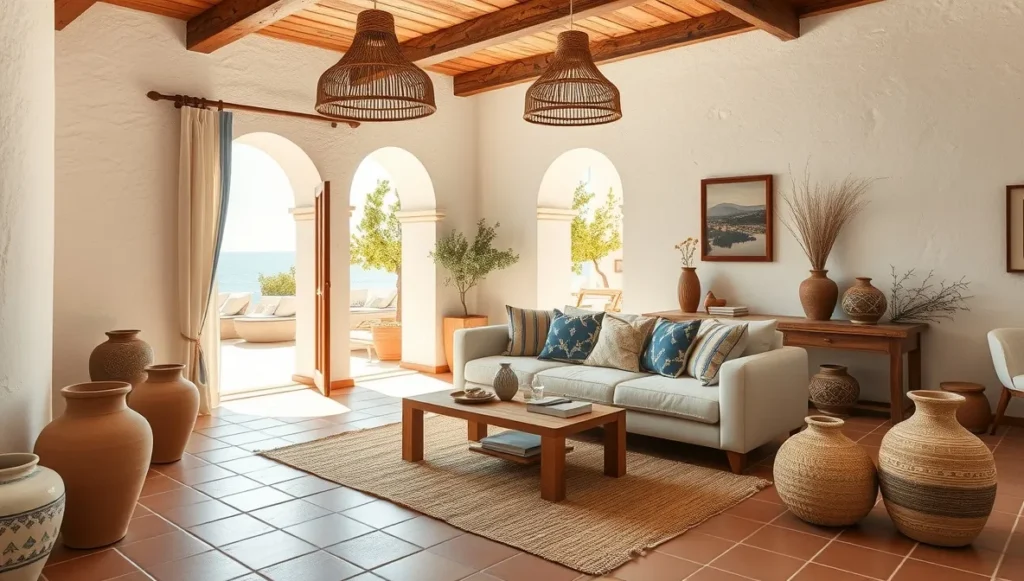- The Timeless Beauty of Portuguese Azulejo: A Designer’s Guide to Bringing Historic Charm into Modern Interiors - September 4, 2025
- Mastering Nautical Interior Design: Beyond the Obvious Anchors and Ship Wheels - September 4, 2025
- Bringing the Tropics Home: A Complete Guide to Tropical Interior Design - September 2, 2025
Table of Contents
Fifteen years ago, I thought Mediterranean design was all about terra cotta pots and wrought iron everything. Boy, was I wrong.
My first “Mediterranean” project was a disaster. Picture this: a beautiful Scottsdale home turned into what looked like a Mexican restaurant crossed with a medieval castle. My client was polite about it, but I could see the disappointment in her eyes when she walked through her newly “designed” living room.
That failure taught me something crucial. Mediterranean isn’t a theme you slap onto a space. It’s a way of living that happens to look beautiful.
What Mediterranean Design Actually Means
Real Mediterranean style comes from centuries of people living along that gorgeous coastline, dealing with hot summers and the need to stay cool. These weren’t design trends, they were practical solutions that happened to create something timeless.
The homes I’ve visited in Tuscany don’t have perfect color coordination. They have walls that have been painted and repainted over decades, furniture collected from different eras, and that wonderful patina that only comes from real life being lived. Here’s one of my friend’s homes in Tuscany. That’s what I try to recreate now. Not the Pinterest version, but the authentic feeling.
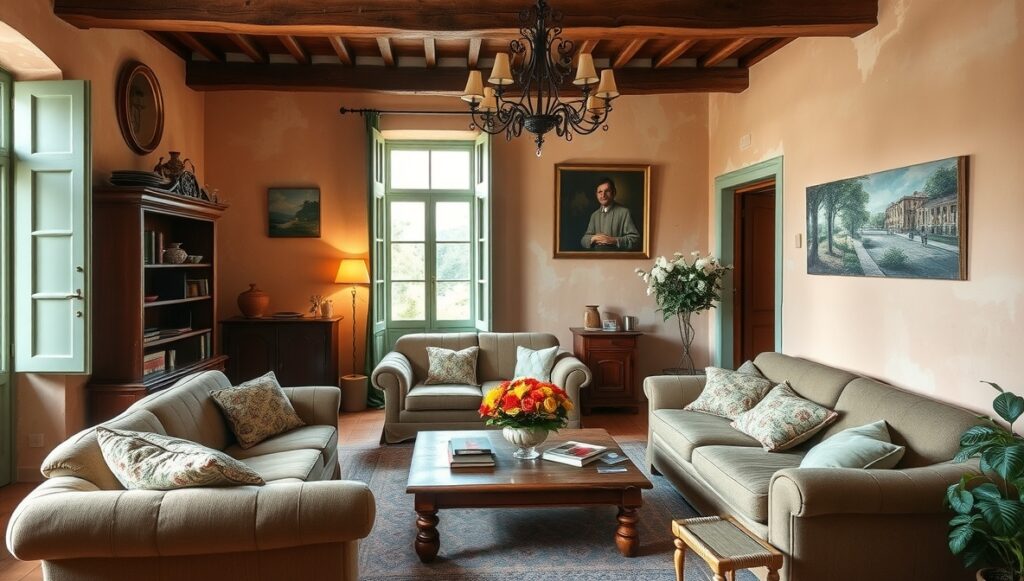
Getting the Colors Right (It’s Not What You Think)
Everyone talks about Mediterranean blue and white. Sure, those colors exist, but walk through any real Mediterranean home and you’ll see something different.
The walls aren’t bright white – they’re cream, oyster, sometimes even slightly gray. The blues aren’t Caribbean bright – they’re faded, like denim that’s been washed a hundred times. And the terra cotta? It’s dusty, muted, not the orange-red you see in home stores.
I learned this the hard way in that Scottsdale project. The colors I chose were too saturated, too new-looking. Now I tell clients to imagine their colors after five years of Mediterranean sun. That’s the palette you want.
My go-to colors these days:
- Walls in warm cream or pale ochre
- Accents in sea-glass green and weathered blue
- Natural wood tones, never too dark
- Stone grays and soft terra cottas
The Texture Secret Nobody Talks About
Here’s something most design articles won’t mention: Mediterranean style is 70% about texture, 30% about everything else.
Smooth, perfect walls kill the vibe instantly. You need texture – hand-troweled plaster if you can afford it, textured paint if you can’t. The goal is walls that look like they have stories to tell.
Same with floors. Polished marble? Too formal. You want tumbled stone, wide-plank wood with character marks, maybe some beautiful old tiles that aren’t perfectly uniform.
I had one client who was obsessed with matching everything perfectly. Took me months to convince her that the slight variations in her stone flooring were features, not flaws. Now it’s her favorite thing about the house.
Room by Room: What Actually Works
Living Areas
Forget the matching furniture sets. Mediterranean living rooms feel collected over time. I start with a comfortable, slipcovered sofa – linen in oatmeal or cream works perfectly. Then I add chairs from different eras. Maybe a vintage leather armchair, a painted wooden side chair, something with character.
Coffee tables should be substantial. I love thick wooden pieces, especially if they show some wear. Stone works too(like the one in the picture). Glass tables? Never. They’re too contemporary for this style.
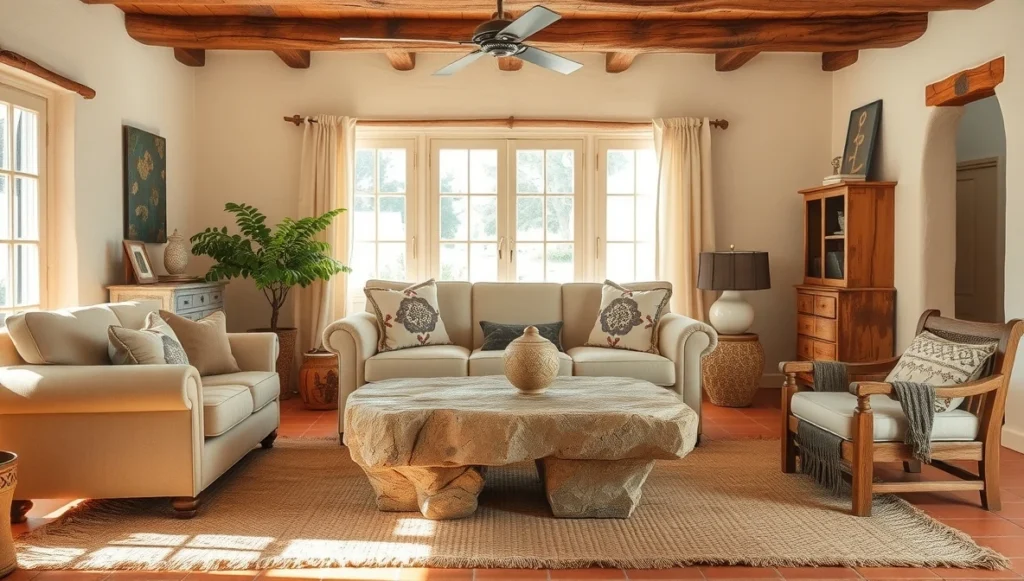
Kitchens That Don’t Look Like Theme Parks
The kitchen is where I see the most Mediterranean fails. People go overboard with the rustic elements and end up with something that looks like a movie set.
My approach is subtler. Good quality cabinets with raised panels, yes, but not necessarily distressed to death. Natural stone counters work beautifully – travertine is my favorite because it ages so well. For backsplashes, subway tile with wide grout lines gives you that handmade feel without screaming “look at me.”
And please, resist the urge to hang dried herbs from every beam. A few well-chosen ceramic pieces on open shelves are much more effective.
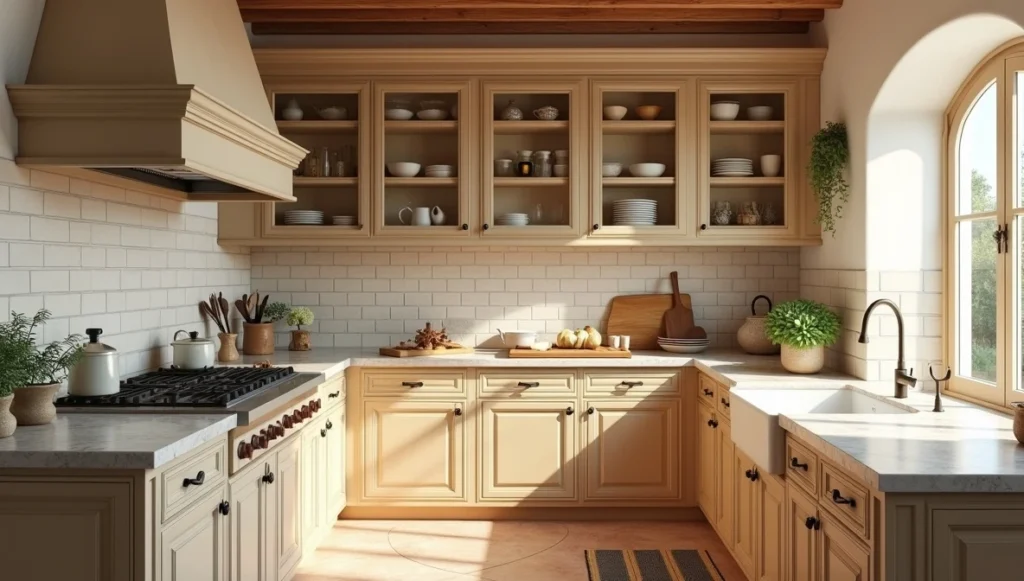
Dining Spaces for Real Life
Mediterranean dining rooms should feel like places where families actually want to spend time. I always start with a substantial wooden table – something that looks like it could handle decades of family dinners.
Seating gets interesting here. Instead of six matching chairs, try four chairs plus a bench. Mix some upholstered pieces with wooden ones. The goal is comfortable elegance, not formal perfection.
Lighting makes or breaks dining rooms. A wrought iron chandelier works, but it doesn’t have to be enormous. I’ve seen too many dining rooms dominated by oversized fixtures that make conversation impossible.
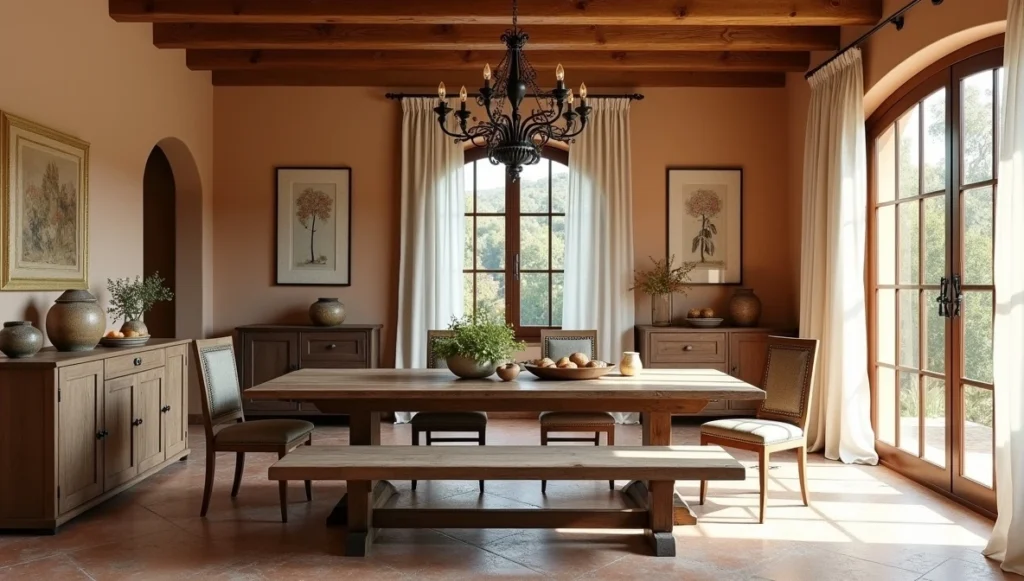
Bedrooms That Feel Like Retreats
Mediterranean bedrooms should whisper relaxation. I usually go with neutral backgrounds – cream walls, natural fiber rugs, linen curtains that filter light beautifully.
The bed is your focal point. Wrought iron frames work wonderfully, but so does a substantial wooden headboard. What doesn’t work? Anything too ornate or shiny.
Nightstands don’t have to match. In fact, they probably shouldn’t. I like pairing a wooden piece with something painted, maybe in that perfect sea-glass green that Mediterranean homes do so well.
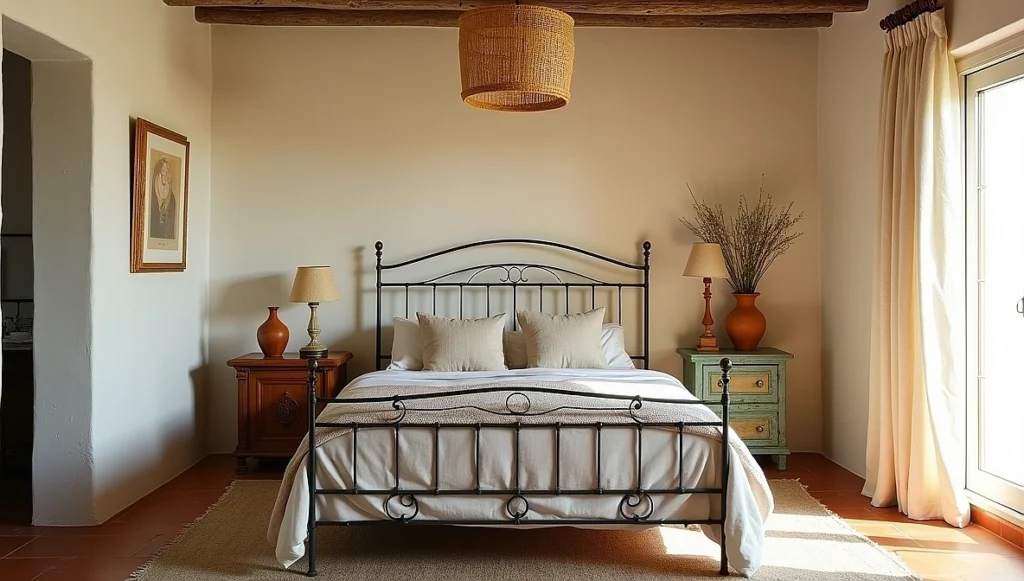
Bathrooms Worth Lingering In
This is where Mediterranean style can really shine. Natural stone feels amazing underfoot, especially travertine with its natural cooling properties.
Vessel sinks in ceramic or stone paired with bronze fixtures create that old-world feel without sacrificing function. If you have the space and budget, a freestanding tub positioned to catch morning light transforms the whole room.
One warning: don’t go crazy with tile patterns. I’ve seen bathrooms that look like mosaic explosions. Choose one beautiful tile and let it be the star.
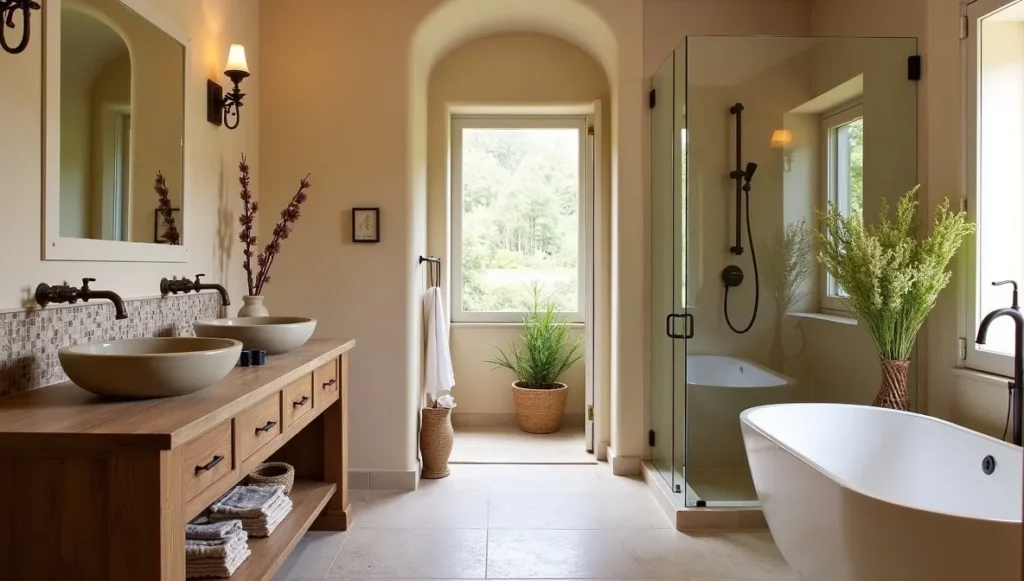
Kids’ Rooms (Yes, They Can Be Mediterranean Too)
Parents always ask me about this. Can Mediterranean work for children? Absolutely, but you have to be smart about it.
Soft, sun-washed colors create calm environments for sleep and play. I avoid bright primaries in favor of pale yellows, sea foam greens, and warm creams.
Wooden furniture that can grow with the child is essential. Skip the themed bedding and go for simple stripes or solids that won’t look babyish in two years.
Storage is crucial. Woven baskets are both beautiful and practical for toy organization. And here’s a trick I learned from a client in Naples: ceramic tiles can create amazing accent walls if placed high enough to avoid damage from flying toys.
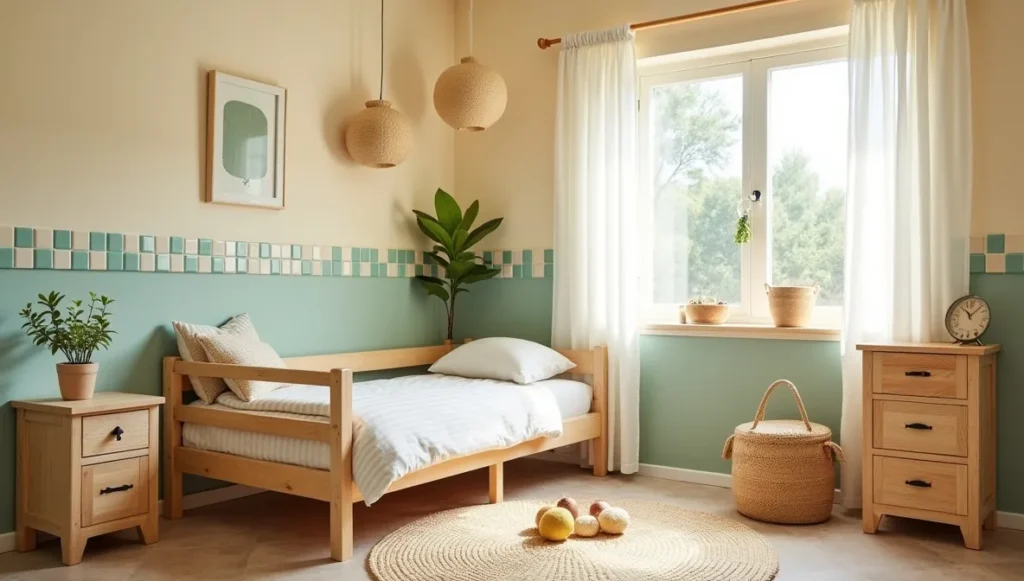
Outdoor Spaces Where Life Happens
This is where Mediterranean design makes the most sense. These cultures practically live outdoors, so outdoor spaces aren’t afterthoughts.
Natural stone or terra cotta tile creates the foundation. Comfortable seating that can handle weather – think teak or powder-coated metal with all-weather cushions in Mediterranean colors.
Plants are essential. If your climate allows, go for lavender, rosemary, maybe even olive trees in large pots. If not, choose plants that give you that Mediterranean feeling – anything with silvery foliage works.
Lighting transforms outdoor spaces after dark. String lights create magic, but invest in good quality LED ones that won’t need constant replacement.
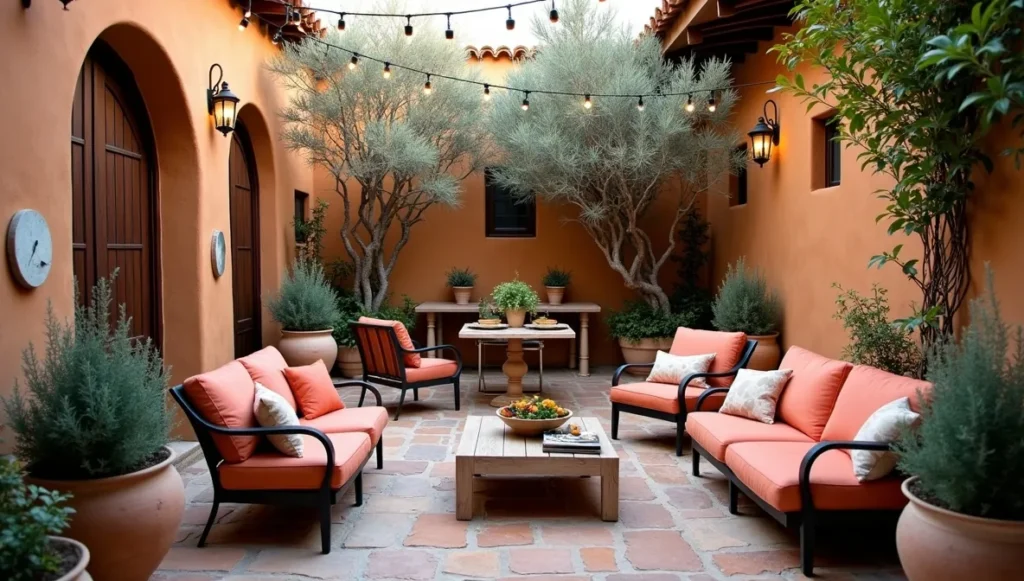
The Mistakes I Still See Everywhere
After all these years, I still see the same errors repeated over and over:
Going Too Matchy-Matchy Everything matching is the kiss of death for Mediterranean style. These spaces should feel collected over generations, not purchased in one weekend shopping trip.
Overdoing the Rustic Elements Yes, Mediterranean style celebrates natural materials and weathered finishes, but there’s a line between charming patina and looking like a theme restaurant. Use restraint.
Ignoring Scale Mediterranean furniture tends to be substantial. Tiny accessories get lost. Better to have fewer, larger pieces than lots of small ones competing for attention.
Forgetting About Comfort All the style in the world doesn’t matter if nobody wants to actually live in the space. Every design decision should pass the comfort test.
Making It Work in Your Real Life
The truth is, most of us aren’t living in Tuscan villas. We’re dealing with suburban homes, city apartments, and budgets that don’t include hand-troweled plaster walls.
That’s okay. Mediterranean style is adaptable.
In a contemporary home, focus on bringing in texture through textiles and accessories. A few pieces of substantial wooden furniture, some beautiful ceramics, the right lighting – these elements can transform a space without major renovation.
For apartments, consider what I call “removable Mediterranean.” Beautiful rugs, linen curtains, ceramic lamps, and plants can create the feeling without permanent changes.
Where to Spend Your Money If you’re working with a limited budget, prioritize these elements:
- One substantial piece of wooden furniture per room
- Good quality textiles in natural fibers
- Proper lighting with warm bulbs and dimmer switches
- A few beautiful ceramic or pottery pieces
Where to Save
- Decorative accessories (flea markets are goldmines)
- Artwork (prints are fine if they’re well-chosen)
- Window treatments (simple linen panels work beautifully)
The Real Secret to Mediterranean Style
After fifteen years and hundreds of projects, I’ve figured out the real secret to authentic Mediterranean design: it’s not about the stuff you buy. It’s about creating spaces that make people want to slow down.
Mediterranean cultures understand something we’ve forgotten in our rush to optimize everything: homes should be refuges. Places where families gather, where friends feel welcome, where life unfolds at a gentler pace.
That’s what I’m really designing for now. Not Instagram moments, but real moments. The kind that happen when your home feels like a place worth lingering in.
Every successful Mediterranean project I’ve completed has that quality. It’s not about perfect execution of design principles – it’s about creating spaces that breathe with warmth and welcome.
That’s the goal worth pursuing.
